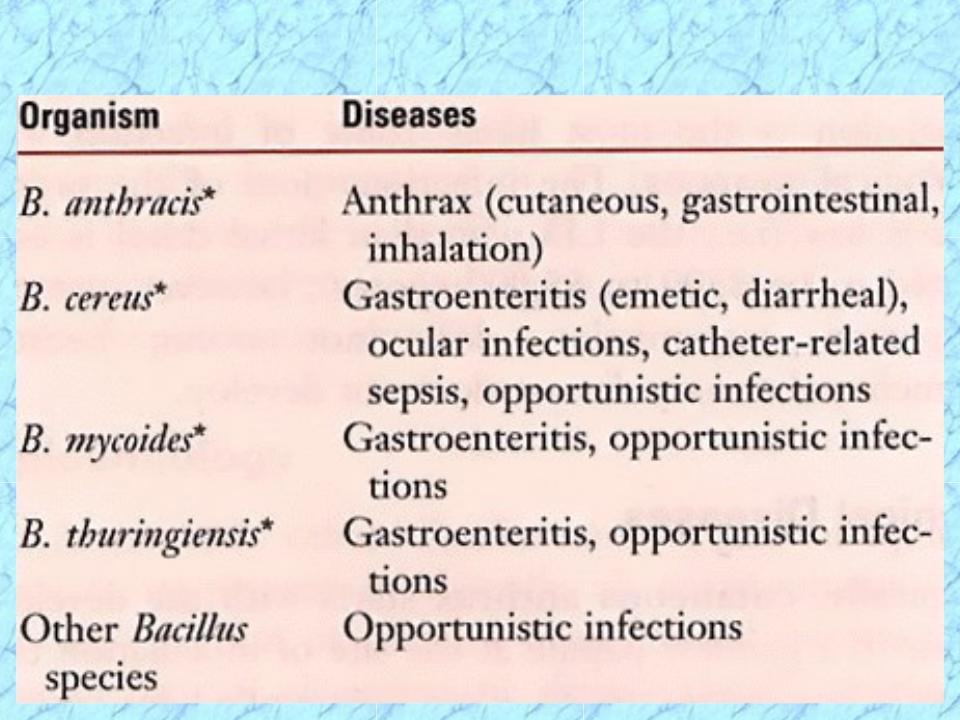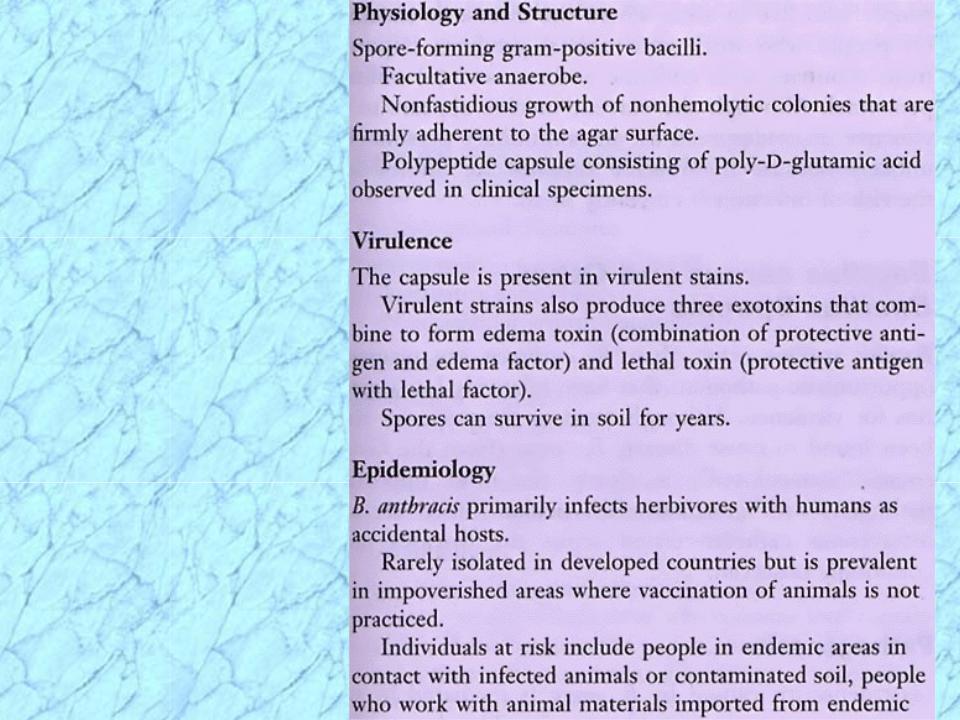
- •Bacillus
- •General Characteristics of Bacillus
- •Diseases Associated with Bacillus
- •Laboratory Characteristics of Bacillus
- •Bacillus anthracis
- •Summary of
- •Summary of
- •Epidemiology of Bacillus anthracis
- •Epidemiology of Bacillus anthracis (cont.)
- •Epidemiology
- •Clinical Presentation of Anthrax
- •Clinical Presentation of Anthrax
- •Clinical Presentation of Anthrax
- •Treatment & Prophylaxis
- •Key Characteristics to Distinguish between B anthracis & Other Species of Bacillus
- •Bacillus cereus
- •Summary of
- •Summary of B. cereus Infections (cont.)
- •Gram-Variable Stain of B. cereus with Endospores
- •Foodborne Diseases of B. cereus
- •Other Bacillus spp.
- •REVIEW
- •General Characteristics of Bacillus
- •Diseases Associated with Bacillus
- •Review of
- •Bacillus anthracis
- •Summary of
- •Summary of
- •Epidemiology
- •Clinical Presentation of Anthrax
- •Clinical Presentation of Anthrax
- •Clinical Presentation of Anthrax
- •Treatment & Prophylaxis
- •Review of
- •Summary of
- •Summary of B. cereus Infections (cont.)
- •Foodborne Diseases of B. cereus


Bacillus

General Characteristics of Bacillus
~ 60 species; Gram-positive or Gram-variable bacilli
•Large (0.5 x 1.2 to 2.5 x 10 um)
•Most are saprophytic contaminants or normal flora
•Bacillus anthracis is most important member
Produce endospores
Aerobic or facultatively anaerobic
Catalase positive (most)
•Rapidly differentiates from Clostridium
Bacillus spp. are ubiquitous
•Soil, water, and airborne dust
•Thermophilic (< 75°C) and psychrophilic (>5-8°C)
•Can flourish at extremes of acidity & alkalinity (pH 2 to 10)

Diseases Associated with Bacillus

Laboratory Characteristics of Bacillus
On blood agar
•Large, spreading, gray-white colonies, with irregular margins
•Many are beta-hemolytic (helpful in differentiating various
Bacillus species from B. anthracis)
Spores seen after several days of incubation, but not typically in fresh clinical specimens


Bacillus anthracis

Summary of
B. anthracis
Infections

Summary of
B. anthracis
Infections
(cont.)

Epidemiology of Bacillus anthracis
Rare in the US (1974-1990, 17 cases reported by CDC)
Enzootic in certain foreign countries (e.g., Turkey, Iran,
Pakistan,and Sudan)
Anthrax spores infectious for decades
•Biologic warfare experiments (annual tests for 20 years)
Gruinard, off western coast of Scotland
4 x 10e14 fully virulent spores exploded
Eliminated in 1987 (formaldehyde & seawater)
Three well-defined cycles
•Survival of spores in the soil
•Animal infection
•Infection in humans

Epidemiology of Bacillus anthracis (cont.)
Primarily a disease of herbivorous animals
Most commonly transmitted to humans by direct contact with animal products (e.g., wool and hair)
Also acquired via inhalation & ingestion
•Increased mortality with these portals of entry
Still poses a threat
•Importing materials contaminated with spores from these countries (e.g., bones, hides, and other materials)
•Usually encountered as an occupational disease
•Veterinarians, agricultural workers
